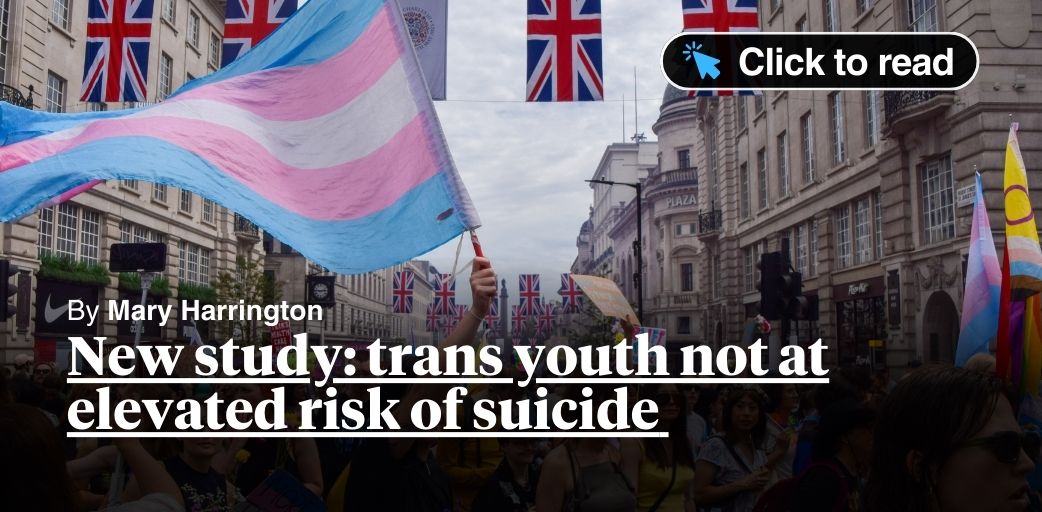
A new study challenges the common assertion that gender-dysphoric youth are at elevated risk of suicide if not treated with “gender affirming” medical interventions. If it’s true, it ought to have a seismic impact on the accepted medical approach to gender-confused youth.
Reported in the BMJ, the study examines data on a Finnish cohort of gender-referred adolescents between 1996 and 2019, and compares their rates of all-cause and suicide mortality against a control group. While suicide rates in the gender-referred group studied were higher than in the control group, the difference was not large: 0.3% versus 0.1%. And — importantly — this difference disappeared when the two groups were controlled for mental health issues severe enough to require specialist psychiatric help.
In other words: while transgender identity does seem to be associated with elevated suicide risk, the link is not very strong. What’s more, the causality may not work the way activists claim.
The association between gender dysphoria and mental illness is well-documented by both providers of “gender-affirming care” and trans advocacy groups and clinical psychology research. But one less well-evidenced claim, based on this association, is that these difficulties are caused not by being transgender, but by the political and social stigma associated with it. Gender dysphoria, we are to understand, is not in itself a mental health issue. What causes mental health issues in transgender youth — up to and including suicide — is the wider world’s rejection of their identity, and of the metaphysical frame of “gender identity” as such.
This is the root of the oft-repeated social media assertion that anyone who demurs about trans identity, however mildly, is complicit in “trans genocide”. The same assertion that invalidating trans youth makes them kill themselves is also behind the rhetorical question routinely used to browbeat parents into consenting to social and medical transition for their gender-confused offspring: “Would you rather have a live daughter or a dead son?”
It’s behind the prohibition on “trans conversion therapy” already in force in several countries, and promised by the Labour Party in England too. Such measures forbid therapists from exploring with their clients whether there is any link between their gender dysphoria and — for example — life trauma or other mental health issues. For logically, if the cause of distress and suicidality in trans people is not being accepted for who they are, any therapist who seeks to explore links between gender dysphoria and other biographic or psychiatric issues is complicit in just this kind of non-acceptance, and is thus not helping but harming their client.
But as the study puts it: “Clinical gender dysphoria does not appear to be predictive of all-cause nor suicide mortality when psychiatric treatment history is accounted for.” Rather, what predicts risk in this population is “psychiatric morbidity”. And contra the activists, transitioning does nothing to reduce it: “medical gender reassignment does not have an impact on suicide risk.”
Every suicide is a tragedy, and leaves grieving loved ones behind. No one wants to be complicit in pushing a young person down that path. So the suggestion that questioning someone’s gender beliefs may have this effect serves as a powerful emotional cudgel. But if the Finnish study is correct, this whole rhetorical, legislative, and medical edifice may be built on sand. If the elevated risk of suicidality in trans youth disappears when you control for other psychiatric difficulties, this suggests strongly that trans youth are not more at risk due to transphobia or invalidation, but due to the well-documented fact that gender dysphoria tends to occur in people who are disturbed and unhappy more generally.
It ought to follow from this that the way to manage suicide risk in trans-identified young people is not to affirm their gender identity and whisk them off for medical interventions, but to watch for and treat psychiatric comorbidities. Ultimately, though, the claims of gender ideology are less scientific than metaphysical. So don’t expect scientific evidence that contradicts its prescriptions to have much impact on trans advocates. Even if “following the science” would make a real difference to suicide risk in gender-dysphoric youth.



